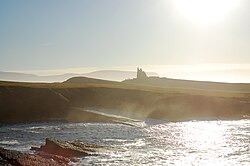Mullaghmore, County Sligo
Mullaghmore
An Mullach Mór | |
|---|---|
Village | |
 A view of Mullaghmore | |
| Country | Ireland |
| Province | Connacht |
| County | County Sligo |
| Elevation | 1 m (3 ft) |
| Population (2006)[1] | |
| • Total | 147 |
| Irish Grid Reference | G709577 |
Mullaghmore (Irish: An Mullach Mór, meaning 'the great summit')[2] is a village in County Sligo, Ireland. It is a noted holiday destination, characterised by ocean views and a skyline dominated by the monolithic shape of Ben Bulben mountain.
It was a favoured holiday retreat of Louis Mountbatten, and it was here that he, along with the Dowager Baroness Brabourne, the Hon. Nicholas Knatchbull and local teenager Paul Maxwell, were killed by a bomb planted by the Provisional IRA in August 1979.
It is the birthplace of historian and author Joe McGowan.
In 2007 it hosted to the final stage of Rally Ireland.
Surfing
| External images | |
|---|---|
| Surfing waves up to 15 metres high on 8 March 2012 | |
Mullaghmore is one of the best big wave surfing locations in the world. On 8 March 2012, surfers and windsurfers from all over the world rode waves up to 15 metres (49 ft) high off Mullaghmore Head. (See external images gallery below.) These waves were about five metres less than the tallest wave ever recorded in Ireland in County Donegal on 13 December 2011, which was 20.4 metres (67 ft) high.[3][4]
The waves in Mullaghmore were generated by a complex weather system nicknamed the "Viking storm" leading to the best big wave conditions in the area for the month of March for 15 years. Some riders suffered bruising as well as broken bones and surf boards.[5][6] A North American low pressure system moved east and combined with another cyclone in the Western Atlantic. This system moved into an area off the coast of Ireland that already had high waves owing to a series of strong systems the previous week. In addition, a strong anticyclone over the Azores created a large pressure gradient in the North Atlantic that directed a strong fetch towards Ireland. There was also an extended fetch length in the North Atlantic in the direction of Europe while the swell was created. These combined conditions produced waves that were confirmed by satellite data on 7 March 2012 to have exceeded 15 metres (49 ft) in height.[7]
See also
External links
References
- ^ "Census 2006 – Volume 1 – Population Classified by Area" (PDF). Central Statistics Office Census 2006 Reports. Central Statistics Office Ireland. 2007. Retrieved 2011-06-05.
{{cite web}}: Unknown parameter|month=ignored (help) - ^ Mullaghmore Placenames Database of Ireland. Retrieved: 2012-03-21.
- ^ Giant 20-metre high wave off Donegal Irish Times, 2011-12-13.
- ^ Donegal wave is a new high water mark Irish Times, 2011-12-14.
- ^ Surfers' paradise: Best March conditions in 15 years Irish Times, 2012-03-12.
- ^ Last Minute XXL Entry From Ireland TransWorld Surf magazine, 2012-03-12.
- ^ Ireland gets XXL surf Surfline, 2012-03-12.

